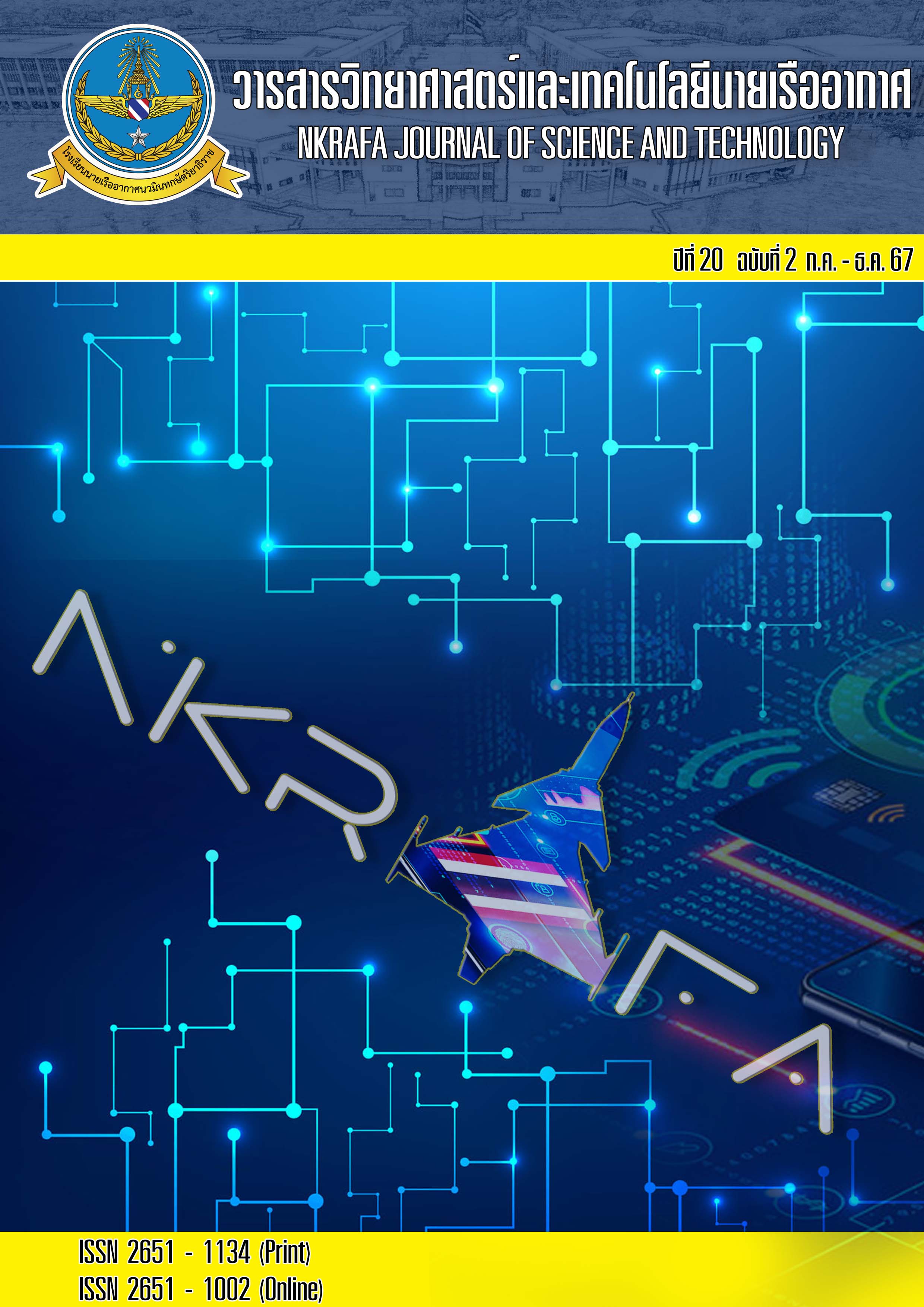Equipment Invention and Protocol Production of Hypochlorous Acid Solution for Disinfection Using in Chulachomklao Royal Military Academy
Main Article Content
Abstract
The purposes of this research include: to invent an equipment set and to produce a protocol for generating Hypochlorous acid (HOCl) solution from electrochemical reaction by using electrolysis of Sodium chloride solution (NaCl) to obtain HOCl solution, which is effective in disinfection for using in Chulachomklao Royal Military Academy (CRMA). A researcher has invented equipment set, a tank capacity of 12 liters, providing easily available and low-cost materials, tools, and substances, including qualitative and quantitative analysis of HOCl solution, and has produced a suitable formula to use as protocol for this equipment set. The results of the research found that using a formula of the starting solution, which is (1) tap water produced by CRMA, 10 liters (2) NaCl 1%w/v and (3) vinegar (5% Acetic acid) 0.3%v/v and then provide current of 12V, 5A DC at least 35 minutes to obtain HOCl solution. The HOCl solution has an approximately available chlorine concentration (ACC) of 200 ppm at pH 4.51, which this pH-value has found to be all the HOCl species or one hundred percentage of available chlorine concentration (100%ACC). Oxidation-reduction potential (ORP) is +934 mV, which is effective enough to disinfect. Therefore, this invented equipment set with the protocol for generating HOCl solution can be practical.
Article Details

This work is licensed under a Creative Commons Attribution-NonCommercial-NoDerivatives 4.0 International License.
- Content and information in articles published in NKRAFA Journal of Science and Technology are comment and responsibility of authors of articles directly. Journal editorial do no need to agree or share any responsibility.
- NKRAFA Journal of Science and Technology Articles holds the copyright of the content, pictures, images etc. which published in it. If any person or agency require to reuse all or some part of articles, the permission must be obtained from the NKRAFA Journal of Science and Technology.
References
World Health Organization. (2020). Cleaning and disinfection of environmental surfaces in the context of COVID-19: Interim guidance 15 May 2020. Retrieved on Jun 20, 2021, from https://apps.who.int/iris/rest/bitstreams/1277966/retrieve
Rahman, S. M. E., Khan, I., & Oh D.-H. (2016). Electrolyzed Water as a Novel Sanitizer in the Food Industry: Current Trends and Future Perspectives. Compr. Rev. Food Sci. Food Saf., 15: 471–490.
นวลใย ญารักษา, ชัดชัย แก้วตา, ศุภาวีร์ มากดี และ ธีระ สาธุพันธ์. (2564). ประสิทธิภาพของน้ำอิเล็กโทรไลต์ชนิดกรดในการฆ่าเชื้อโรค. วารสารเกษตรพระวรุณ. 18(2): 41–48.
Block, M. S., & Rowan, B. G. (2020). Hypochlorous Acid: A Review. J. Oral Maxillofac. Surg., 78: 1461–1466.
Farah, R. I., & Al-Haj Ali, S. N. (2021). Electrolyzed Water Generated On-Site as a Promising Disinfectant in the Dental Office During the COVID-19 Pandemic. Front. Public Health, 9: 1–5.
Takeda, Y., Matsuda, S., Jamsransuren, D., & Ogawa, H. (2021). Comparison of the SARS-CoV-2-Inactivating Activities of the Differently Manufactured Hypochlorous Acid Water Products with Various pH. J. Water Health., 19(3): 448–456.
HydroVoltage. (2021). ผลิตน้ำไฮโปคลอรัสเอซิดเองที่บ้านต่อสู้โควิด19. Retrieved on Jun 20, 2021, from https://fliphtml5.com/th/libqk/vwmk/basic
มหาวิทยาลัยสงขลานครินทร์, คณะวิทยาศาสตร์. (2564). นักวิจัย ม.อ. ผลิตน้ำยาฆ่าเชื้อโควิด-19 พร้อมถ่ายทอดองค์ความรู้ สู่ชุมชน [ข่าวในสื่อ]. สืบค้น 20 มิ.ย. 2564, จาก https://www.sci.psu.ac.th/wp-content/uploads/2021/05/นักวิจัยม-อ-ผลิตน้ำยาฆ่าเชื้อโควิด-19-พร้อมถ่ายทอดองค์ความรู้สู่ชุมชน-.pdf
มหาวิทยาลัยเกษตรศาสตร์ วิทยาเขตกำแพงแสน, คณะศิลปศาสตร์และวิทยาศาสตร์. (2564). คณะศิลปะศาสตร์และวิทยาศาสตร์ ผลิตน้ำยาฆ่าเชื้อโรคจากกรดไฮโปคลอรัส (HYPOCHLOROUS ACID) ใช้แทนแอลกอฮอล์ [ข่าววิทยาเขต]. สืบค้น 20 มิ.ย. 2564, จาก https://kps.ku.ac.th/v8/index.php/th/news-all/kps-news/1515-คณะศิลปศาสตร์และวิทยาศาสตร์-ผลิตน้ำยาฆ่าเชื้อโรคจากกรดไฮโปคลอรัส-hypochlorous-acid-ใช้แทนใช้แทนแอล
คลอริน็อกซ์. (ม.ป.ป.). เครื่องผลิตน้ำยาฆ่าเชื้อโรค HOCl ฆ่าเชื้อโควิด-19 ได้ 99.5%. สืบค้น 20 มิ.ย. 2564, จาก https://chlorinox.co/products/
มหาวิทยาลัยราชภัฏเพชรบุรี. (ม.ป.ป.). ระบบทำน้ำยาฆ่าเชื้อโรคด้วยกรดไฮโปคลอรัสเข้มข้นจากน้ำเกลือด้วยกระบวน การอิเล็กโทรลิซิส [ข่าวสาร]. สืบค้น 20 มิ.ย. 2564, จาก https://www.pbru.ac.th/pbru/news/15290
Hypo Source. (2021). NEW Hypo 7.5 Hypochlorous Acid Generator. Make 2 gallons HOCl in 8 minutes. Retrieved on Jun 20, 2021, from https://hyposource.com/collections/hypochlorous-acid-generators/products/hypo-7-5
YouTube, เผือกไปกับช่าง Channel. (2563). สอนทำน้ำไฮโปคลอรัสฆ่าเชื้อโควิด-19 ตายใน 10 วินาที ผ่านแท่งแกรไฟต์. สืบค้น 20 มิ.ย. 2564, จาก https://www.youtube.com/watch?v=qNtOUkAeRBs&t=20s
Sukwaree, J., Srisungwan, P., Sirivej, T., Thongsri, S., & Khongton, N. (2021). Hypochlorous Acid Solution Generator Prototype for Disinfection. (Cadets’ Research Project Report, Chulachomklao Royal Military Academy).
Pawongjit, K., Sathaworn, K., Rittidech, T., & Wilailoy, N. (2022). Using Acids to Control pH for Producing Hypochlorous Acids Solution. (Cadets’ Research Project Report, Chulachomklao Royal Military Academy).
Agricultural Marketing Service. (2015). Hypochlorous Acid Petition [Unpublished Manuscript]. Retrieved on Jun 20, 2021, from https://www.ams.usda.gov/sites/default/files/media/Hypochlorous%20Acid%20Petition.pdf
Al-Haq, M. I., Sugiyama, J., & Isobe S. (2005). Applications of Electrolyzed Water in Agriculture and Food Industries. Food Sci. Technol. Res., 11(2): 135–150.
วิยดา กวานเหียน, ดลฤดี ตวงสิน และ สุนิษา ฐานะภักดี. (2562). คุณสมบัติการฆ่าเชื้อก่อโรคของน้ำออกซิไดซ์. วารสารพิษวิทยาไทย. 34(1): 53–69.
Agency for Toxic Substances and Disease Registry. (2010). Toxicological Profile for Chlorine: 4. Chemical and Physical Information. Retrieved on Jun 20, 2021, from https://www.atsdr.cdc.gov/ToxProfiles/tp172-c4.pdf
World Health Organization. (2020). Hypochlorous Acid (HOCl) for disinfection, antisepsis, and wound care in. Core Categories 15.1, 15.2, and 13. Retrieved on Jun 20, 2021, from https://cdn.who.int/media/docs/default-source/essential-medicines/2021-eml-expert-committee/applications-for-addition-of-new-medicines/a.18_hypochlorous-acid. pdf?sfvrsn=35222172_4
Guentzel, J. L., Lam, K. L., Callan, M. A., Emmons, S. A. & Dunham, V.L. (2008). Reduction of bacteria on spinach, lettuce, and surfaces in food service areas using neutral electrolyzed oxidizing water. Food Microbiol., 25: 36–41.
Wang, L., Bassiri, M., Najafi, R., Najafi, K., Yang, J., Khosrovi, B., Hwong, W., Barati, E., Belisle, B., Celeri, C., & Robson M. C. (2007). Hypochlorous Acid as a Potential Wound Care Agent: Part I. Stabilized Hypochlorous Acid: A Component of the Inorganic Armamentarium of Innate Immunity. J. Burns Wounds. 11; 65–79.
Aquaox. (2019). Welcome to the Next Generation of Infection Control. Retrieved on Jun 20, 2021, from https://www.aquaox.com/wp-content/uploads/2019/03/Aquaox-ICS-Introduction.pdf
Stevenson, S. M. L., Cook, S. R., Bach, S. J., & Mcallister, T. A. (2004). Effects of Water Source, Dilution, Storage, and Bacterial and Fecal Loads on the Efficacy of Electrolyzed Oxidizing Water for the Control of Escherichia coli O157:H7. J. Food Prot., 67(7): 1377–1383.
Hao, X. X., Li, B. M., Wang, C. Y., & Cao, W. (2013). Application of Slightly Acidic Electrolyzed Water for Inactivating Microbes in a Layer Breeding House. Poult Sci., 92(10): 2560–2566.
ประกาศกรมอนามัย. (2543). เรื่อง เกณฑ์คุณภาพน้ำประปา. สืบค้น 20 มิ.ย. 2564, จาก https://www.metlaboratory.com/ album/law/pdf/76ed7168141b2288e444611cd52d0114.pdf


